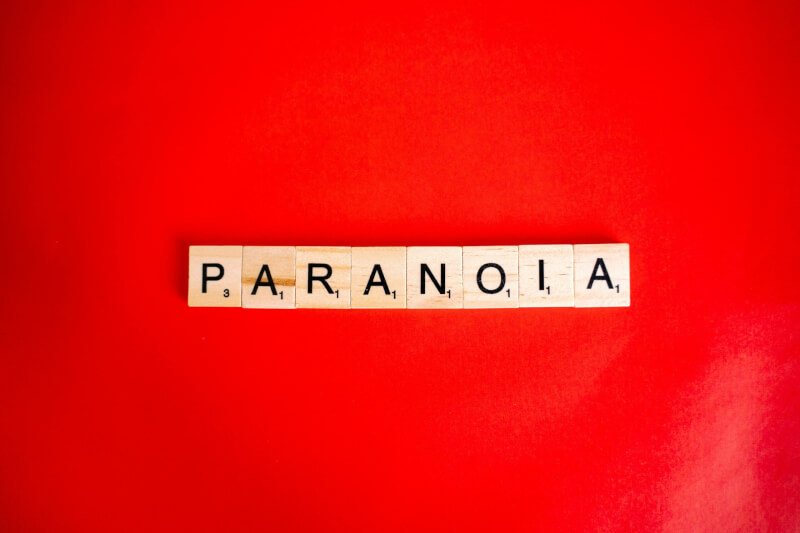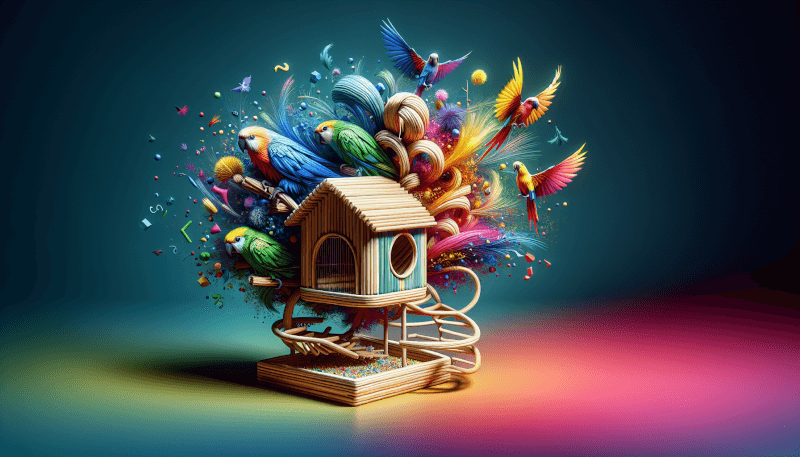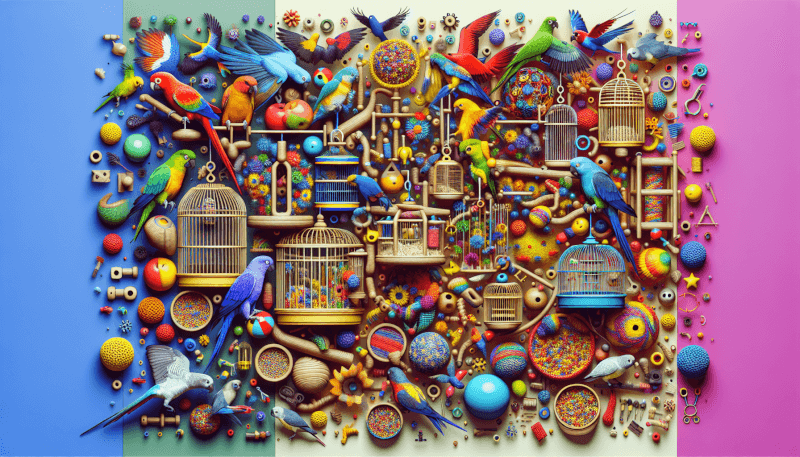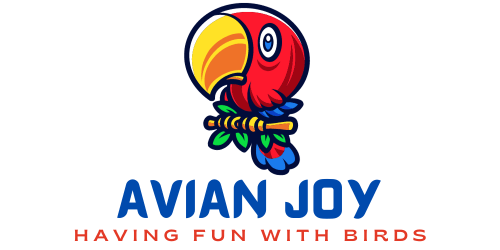Have you ever wondered how to keep your feathered friend mentally stimulated and entertained? Well, look no further! In this article, you will discover the best ways to promote avian mental stimulation, ensuring that your beloved bird remains happy, engaged, and mentally sharp. From interactive toys to puzzle feeders, we will explore various methods that will keep your avian companion entertained and stimulated throughout the day. So, let’s dive into the world of avian mental stimulation and discover the secrets to keeping your bird’s mind active and vibrant!

Provide Interactive Toys
Choose toys that require problem-solving skills
Interactive toys are a great way to stimulate the mental abilities of your bird. When selecting toys, opt for those that require problem-solving skills. These toys often have hidden compartments or mechanisms that your bird needs to figure out in order to access a treat or a reward. For example, puzzle toys or toys with removable parts that require your bird to manipulate them in the correct way can be highly engaging and mentally stimulating.
Select toys that encourage foraging
Foraging toys are another fantastic option to provide mental stimulation for your bird. These toys mimic the natural foraging behavior that birds would engage in the wild. They typically involve hiding food or treats within compartments or behind obstacles that your bird needs to work to access. These toys stimulate your bird’s natural instincts and provide an entertaining challenge.
Rotate toys regularly
To ensure continued mental stimulation, it’s vital to rotate your bird’s toys regularly. Birds can quickly become bored with the same toys, so introducing new toys or changing their placement can help keep your feathered friend engaged. Consider having a few sets of toys that you rotate on a weekly or bi-weekly basis. This way, your bird will always have something new and exciting to explore.
Create an Enriching Environment
Offer a variety of perches
Birds spend a significant amount of their time perched, so offering a variety of perches can provide mental and physical stimulation. Different types of perches, such as natural branches of various thicknesses, rope perches, and platforms, can help develop your bird’s foot muscles and allow for different levels of engagement. Additionally, varying the height and location of perches within the cage can promote variety and exploration.
Provide different textures and materials
Birds enjoy exploring different textures and materials with their beaks and feet. Incorporating a range of materials, such as ropes, leather, wood, and even stainless steel, can allow your bird to exercise its senses and engage in natural behaviors. Including items with different shapes and sizes will further enhance the diversity of stimulation and enrichment in their environment.
Include branches and natural elements
Bringing a piece of nature into your bird’s cage can greatly enrich their living space. Adding branches or twigs can simulate the feeling of perching on a tree branch, providing a more natural and stimulating environment. Additionally, incorporating safe, non-toxic plants or greenery in the cage can create a visually appealing and mentally stimulating atmosphere for your bird.

Engage in Training and Social Interaction
Teach your bird new tricks and commands
Training your bird to learn new tricks and commands can be an enriching and mentally stimulating experience for both of you. Birds are highly intelligent and capable of learning a wide range of behaviors. Start with simple commands, such as “step up” or “wave,” and gradually progress to more complex tricks. Use positive reinforcement techniques, such as treats or praise, to reward your bird’s efforts and reinforce desired behaviors.
Play games with your bird
Engaging in interactive games with your bird can provide mental stimulation while strengthening the bond between you. Games like hide and seek, where you hide a treat or toy and encourage your bird to find it, can be highly entertaining for them. Alternatively, playing games that involve tossing or rolling toys for your bird to retrieve can also be engaging and mentally stimulating.
Provide regular opportunities for socializing
Birds are social creatures and thrive on social interaction. Providing regular opportunities for your bird to socialize with you and other bird-friendly individuals can greatly enhance their mental well-being. Allow your bird out of the cage for supervised playtime, where they can interact with you, explore their surroundings, and interact with other household members. This social interaction helps prevent boredom and loneliness, keeping their minds active and engaged.
Introduce Puzzles and Treat Toys
Use puzzle toys that require problem-solving
Puzzle toys are an excellent way to challenge your bird’s problem-solving skills and provide mental stimulation. These toys often have different compartments or mechanisms that your bird must navigate to access hidden treats or rewards. By encouraging your bird to solve puzzles, you are promoting their cognitive abilities and keeping them mentally sharp. Start with beginner-level puzzles and gradually increase the difficulty as your bird becomes more adept at solving them.
Fill treat toys with bird-safe foods
Treat toys can be a fun and engaging way to provide additional mental stimulation and reward your bird. Fill treat toys with a variety of bird-safe foods, such as small pieces of fruits, vegetables, or nuts. Your bird will have to work to extract the treats from the toy, keeping their mind active and engaged as they enjoy their favorite treats. Ensure that the treats you use are appropriate for your bird’s species and size to avoid any health issues.
Hide treats for your bird to find
Hiding treats throughout your bird’s cage or play area can add an element of excitement and mental stimulation to their daily routine. Birds have a natural instinct to forage for food, and hiding treats encourages them to engage in this instinctive behavior. Hide treats in various locations, such as under toys, behind perches, or in foraging boxes, and watch as your bird explores and discovers their delicious rewards.

Offer Foraging Opportunities
Provide foraging boxes filled with shredded paper
Foraging boxes are a simple yet effective way to promote mental stimulation in your bird. Fill a small box with shredded paper and hide treats or small toys within it. Your bird will have to dig through the paper to find the hidden treasures, mimicking the foraging behavior they would engage in the wild. This activity not only stimulates their mind but also provides physical exercise as they search for their rewards.
Hang food and treats from the cage bars
Hanging food and treats from the cage bars adds an element of challenge and mental stimulation to your bird’s daily routine. Attach pieces of fruits, vegetables, or bird-safe treats to clips or skewers and hang them within reach of your bird. They will have to figure out how to access the delicious treats, keeping their mind and beak active. Make sure the clips or skewers are securely fastened to prevent accidents.
Hide food in various locations
Hide small portions of your bird’s regular food or treats in different areas of their cage or play area. By scattering the food in various locations, you encourage your bird to explore and forage for their meals, much like they would in the wild. This activity not only provides mental stimulation but also keeps your bird physically active as they search for their hidden sustenance.
Provide Visual Stimulation
Place a bird-safe mirror in the cage
Birds are visually-oriented creatures, and providing visual stimulation is essential for their overall well-being. Consider placing a bird-safe mirror in your bird’s cage to provide them with an interesting visual companion. Birds often enjoy interacting with their own reflections, which can provide entertainment and mental stimulation. However, it’s crucial to choose a mirror specifically designed for birds and monitor your bird’s interaction to ensure they do not become overly fixated on their reflection.
Hang colorful toys and mobiles
Adding colorful toys and mobiles to your bird’s environment can enhance their visual stimulation. Birds are attracted to vibrant colors, and hanging colorful toys or mobiles in their cage can catch their attention and encourage exploration. Opt for toys that are safe for birds and made from non-toxic materials. The movement and visual appeal of these toys can keep your bird engaged and mentally stimulated, even when you are not directly interacting with them.
Display pictures or videos of birds in action
Another way to provide visual stimulation for your bird is to display pictures or videos of birds in action. Birds are known to be highly social creatures and enjoy observing and learning from their surroundings. Consider placing a small television or tablet within view of your bird’s cage and play videos of birds in their natural habitats. This visual stimulation can pique their curiosity and provide mental engagement during their alone time.

Utilize Music and Sounds
Play calming or soothing music
Music can have a profound effect on an animal’s well-being, and birds are no exception. Playing calming or soothing music in your bird’s environment can create a peaceful and stress-free atmosphere. Birds often respond positively to classical music or nature sounds like gentle rain or ocean waves. Experiment with different types of music to find what your bird enjoys and responds to the most.
Expose your bird to nature sounds
In addition to music, exposing your bird to realistic nature sounds can be highly stimulating. Playing recordings of birdsongs, chirping insects, or nature sounds can simulate the natural environment and make your bird feel more connected to its species. These auditory experiences engage their senses and bring a sense of peace and tranquility to their surroundings.
Vary the types of music and sounds
To prevent your bird from becoming bored or desensitized to a particular type of music or sound, it is essential to provide variety. Birds thrive on novelty, so consider creating playlists or using sound machines that offer a diverse range of music styles and nature sounds. Rotating the types of music and sounds will keep your bird’s auditory senses engaged and prevent habituation.
Provide Nutritional Variety
Offer a variety of fruits and vegetables
A varied diet is crucial for your bird’s overall health and well-being. Including a variety of fruits and vegetables in their daily diet not only provides essential nutrients but also offers mental stimulation. Birds naturally enjoy exploring new flavors and textures, so introducing different fruits and vegetables can keep them mentally engaged. Be sure to research which fruits and vegetables are safe for your specific bird species and consult with your avian veterinarian for guidance.
Include different types of seeds and nuts
Seeds and nuts are a staple in many bird diets, and offering different types can add variety and mental stimulation to your bird’s feeding routine. Consider providing a mix of seeds, such as sunflower seeds, pumpkin seeds, or millet, to offer a range of tastes and textures. Additionally, nuts, like almonds, walnuts, or pecans, can be offered as treats and foraging rewards, allowing your bird to work for their food and keeping their minds active.
Rotate the types of pellets or formulated diets
If your bird’s diet includes pellets or formulated diets, consider rotating between different brands or flavors to provide both nutritional and mental variety. Birds can become bored with the same food day after day, so switching up the flavors can keep them interested and engaged during mealtime. Consult with your avian veterinarian to ensure you are providing a well-balanced and appropriate diet for your bird’s specific needs.

Practice Environmental Enrichment
Rearrange cage furniture and accessories
Birds are highly observant creatures, and their cage environment can quickly become monotonous if not periodically changed. Rearranging your bird’s cage furniture and accessories can provide mental stimulation by creating a new and exciting space for them to explore. Move perches, toys, and food dishes to different positions, and observe how your bird navigates and interacts with their updated environment.
Change the location of the cage periodically
In addition to rearranging the cage interior, consider changing the location of the entire cage periodically. Moving the cage to a different room or even just a different spot within the same room can stimulate your bird’s senses. The change in surroundings can provide new sights, sounds, and smells, keeping your bird mentally engaged. Ensure that the new location is safe and suitable for your bird’s needs.
Introduce new objects or decorations
Introducing new objects or decorations to your bird’s environment can spark their curiosity and provide mental stimulation. Add new toys, perches, or hanging objects, featuring different colors, textures, and shapes. Consider items that encourage play, exploration, and problem-solving. Offer new chew toys, puzzle toys, or even bird-friendly mirrors to keep your bird engaged and constantly learning in their environment.
Give Attention and Interaction
Spend quality time interacting with your bird
Perhaps the most important aspect of providing mental stimulation for your bird is spending quality time interacting with them. Birds are highly social creatures and crave attention and interaction from their human companions. Set aside dedicated daily time to interact with your bird, engaging in activities like talking, singing, or whistling to them. Physical interaction, such as gentle head scratches or playing with safe toys together, strengthens the bond between you and keeps your bird mentally stimulated.
Provide toys and activities during alone time
When you’re unable to directly interact with your bird, it’s important to provide toys and activities to keep them mentally engaged and entertained during their alone time. Select toys that offer a challenge or require problem-solving, such as puzzle toys or treat-dispensing toys. Rotate these toys regularly to maintain their novelty. Additionally, hanging safe toys from the cage bars can offer independent entertainment and mental stimulation for your bird.
Offer treats and rewards for positive behaviors
Positive reinforcement is a valuable tool when it comes to promoting mental stimulation in your bird. Offer treats and rewards for positive behaviors, such as learning new tricks or completing a puzzle toy. This incentivizes your bird to engage in mentally stimulating activities, as they associate these behaviors with positive experiences and rewards. Choose small, bird-friendly treats that are appropriate for your bird’s species and size.
By incorporating these various strategies and activities into your bird’s daily routine, you can ensure that they receive the mental stimulation they need to maintain optimal mental and emotional well-being. Remember, a happy and mentally engaged bird is a healthy and fulfilled bird. So go ahead, get creative, and provide a stimulating and enriching environment for your feathered friend.


